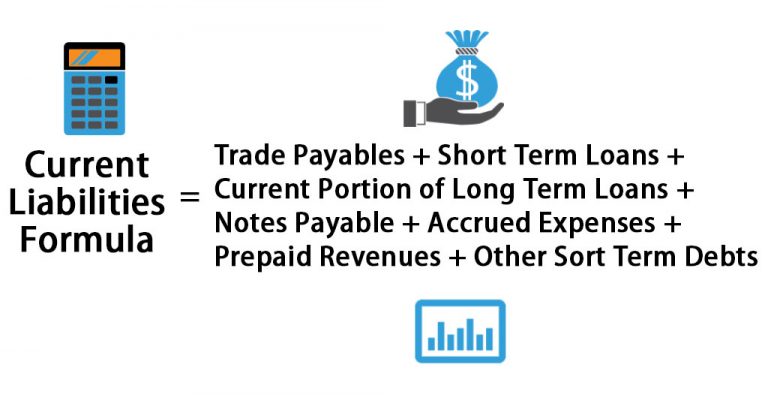
For example,investors and creditors look to the current liabilities to assistin calculating a company’s annual burnrate. The burn rate is the metric defining the monthly andannual cash needs of a company. For example, assume that each time a shoe store sells a $50 pair of shoes, it will charge the customer a sales tax of 8% of the sales price. The $4 sales tax is a current liability until distributed within the company’s operating period to the government authority collecting sales tax. Taxes payable refers to a liability created when a company collects taxes on behalf of employees and customers or for tax obligations owed by the company, such as sales taxes or income taxes. A future payment to a government agency is required for the amount collected.
Other Current Liabilities
Each of these liabilities is current because it results from a past business activity, with a disbursement or payment due within a period of less than a year. Current assets are short-term assets that can be easily liquidated and turned into cash a current liability is defined as: in the upcoming 12 month period. Current assets include accounts such as cash, short-term investments, accounts receivable, prepaid expenses, and inventory. Current liabilities are the financial obligations due in the upcoming 12 month period.
Ask Any Financial Question
The entry would include a debit to the salaries and tax expense accounts and a credit to the salaries and tax payable accounts. When the money is actually paid out to the respective parties, the entry would be a debit to the salaries and tax payable accounts and a credit to cash. Current liabilities are reported in order of settlement date separately from long-term debt on the balance sheet. Payables, like accounts payable, with settlement dates closer to the current date are listed first followed by loans to be paid off later in the year. This allows external users the ability to analyze the liquidity and debt coverage of a company. In other words, they can analyze how many debts will become due in the next year and whether or not the company will have enough short-term resources to pay these debts when they become due.
- If the business doesn’t have the assets to cover short-term liabilities, it could be in financial trouble before the end of the year.
- However, the list does include the current liabilities that will appear in most balance sheets.
- Although payments are made to long-term debt in the current period, these loans are not settled or paid in full during the current period.
- Short-term debts can include short-term bank loans used to boost the company’s capital.
- At first, start-ups typically do not create enoughcash flow to sustain operations.
Short-Term and Current Long-Term Debt
In most cases, you will see a list of types of current liabilities and the amount owed in each category. Ideally, suppliers would like shorter terms so that they’re paid sooner rather than later—helping their cash flow. Suppliers will go so far as to offer companies discounts for paying on time or early.
For example, a large car manufacturer receives a shipment of exhaust systems from its vendors, to whom it must pay $10 million within the next 90 days. Because these materials are not immediately placed into production, the company’s accountants record a credit entry to accounts payable and a debit entry to inventory, an asset account, for $10 million. When the company pays its balance due to suppliers, it debits accounts payable and credits cash for $10 million.
Current Portion of a Note Payable

The first of the following accounting period, the adjusting journal entry will reverse with a debit to the accrued expense account and a credit to the related expense account. When a company receives an invoice from a vendor, it enters a debit to the related expense account and a credit to the accounts payable account. When the invoice is paid, a second entry is made to debit accounts payable and credit the cash account– a reduction of cash.
Current liabilities are obligations that must be paid within one year or the normal operating cycle, whichever is longer, while non-current liabilities are those obligations due in more than one year. These advance payments are called unearned revenues and include such items as subscriptions or dues received in advance, prepaid rent, and deposits. Because current liabilities are payable in a relatively short period of time, they are recorded at their face value. This is the amount of cash needed to discharge the principal of the liability.
Sometimes, companies use an account called other current liabilities as a catch-all line item on their balance sheets to include all other liabilities due within a year that are not classified elsewhere. The most common current liabilities include accounts payable, notes payable, taxes payable, accrued wages, and unearned income—so basically any payable that will require payment in full within the current accounting period. Debts with terms that extend beyond the next 12 months are not considered short-term liabilities. A note payable is usually classified as a long-term (noncurrent) liability if the note period is longer than one year or the standard operating period of the company. However, during the company’s current operating period, any portion of the long-term note due that will be paid in the current period is considered a current portion of a note payable. The outstanding balance note payable during the current period remains a noncurrent note payable.
However, during thecompany’s current operating period, any portion of the long-termnote due that will be paid in the current period is considered acurrent portion of a note payable. The outstandingbalance note payable during the current period remains a noncurrentnote payable. On the balance sheet, the current portion of thenoncurrent liability is separated from the remaining noncurrentliability. No journal entry is required for this distinction, butsome companies choose to show the transfer from a noncurrentliability to a current liability.



